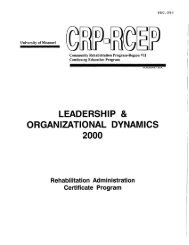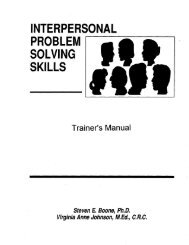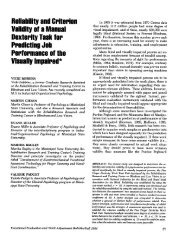by requirements for the degree of (Education) - NCRTM
by requirements for the degree of (Education) - NCRTM
by requirements for the degree of (Education) - NCRTM
Create successful ePaper yourself
Turn your PDF publications into a flip-book with our unique Google optimized e-Paper software.
primary focus <strong>of</strong> school problems should be concerned with functioning in<br />
<strong>the</strong> community, and <strong>the</strong> curriculum should include both academic and voca-<br />
tional training. O<strong>the</strong>r aids in job preparation would include role playing<br />
tours <strong>of</strong> business facilities, and visits to employment .agencies. Work<br />
colonies and sheltered workshops can provide learning under approximately<br />
normal-type work conditions. The physical environment, however, is consi-<br />
dered secondary to <strong>the</strong> psychological <strong>requirements</strong>. Rehabilitation coun-<br />
seling may aid considerably in obtaining successful placement, and follow-<br />
up <strong>of</strong> job placements helps ensure continued and effective personal-social-<br />
adjustment <strong>of</strong> <strong>the</strong> retardate. Finally, misconceptions concerning<br />
economic<br />
mentally retarded worker need to be explain:., through a Program <strong>of</strong> public<br />
<strong>the</strong><br />
education with emphasis on discussion, publicity, and adult education<br />
courses.<br />
A number <strong>of</strong> problems relative to <strong>the</strong> employment <strong>of</strong> <strong>the</strong> retarded are:<br />
i) <strong>the</strong> cost <strong>of</strong> training and education Pr0gram.s which make it possible <strong>for</strong><br />
<strong>the</strong> retarded to prepare <strong>the</strong>mselves <strong>for</strong> employment, 2) <strong>the</strong> employer's fear<br />
<strong>of</strong> <strong>the</strong> risk involved, especially fear <strong>of</strong> accidents, 3) <strong>the</strong> public attitude<br />
that <strong>the</strong> mentally retarded person is a child, not an .adult, 4) physical<br />
appearance ra<strong>the</strong>r than ability, 5) <strong>the</strong> problem <strong>of</strong> labeling people <strong>by</strong> clas-<br />
sifications and intelligence quotients, 6) <strong>the</strong> need <strong>for</strong> sheltered housing<br />
<strong>for</strong> some retarded who are successfully employed but who still need some<br />
assistance in counseling and guidance during leisure hours in order to<br />
maintain employment (Dybwad, 1962).<br />
Focusing upon <strong>the</strong> retarded individual himself with regard to his par-.<br />
ticular employment problems, a study <strong>by</strong> <strong>the</strong> Minneapolis School System<br />
concluded that "behavior shaping needs to be a calculated and integral<br />
part <strong>of</strong> <strong>the</strong> habilitation Program.<br />
'' Their follow-up study demonstrated that:<br />
29
















